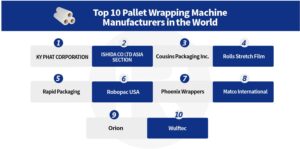Are you tired of seeing your company’s stretch film waste pile up and feeling overwhelmed by the impact on the environment? Look no further! Our comprehensive guide offers effective recycling and disposal strategies that can help save money and improve sustainability in any industry. Discover practical tips for reducing stretch film waste and take a step towards a more eco-friendly future.
6Tips for Reducing Stretch Film Waste:
Conduct a waste audit
Use the right amount of film
Choose high-quality film
Use pre-stretching technology
Implement recycling programs
Consider alternative packaging methods
Are you ready to join the fight against stretch film waste and take a step towards a more sustainable future?
Definition of stretch film
Stretch film, also known as pallet wrap, is a thin plastic material used to secure and protect goods during transportation or storage. It is commonly made from polyethylene or PVC and is available in various thicknesses, colors, and sizes. Stretch film has become an essential tool in the packaging industry due to its flexibility, durability, and cost-effectiveness.
Importance of reducing stretch film waste
However, with the rise of environmental concerns, proper waste management has become more critical than ever. Stretch film waste can have a significant impact on the environment, contributing to pollution and landfill overcrowding. Reducing stretch film waste has become an important goal for companies seeking to improve their sustainability efforts and reduce costs related to waste disposal.
The Impact of Stretch Film Waste
Environmental impact of stretch film waste
The impact of stretch film waste extends beyond just its physical presence in landfills. The environmental impact of stretch film waste includes the release of harmful greenhouse gases and other toxins during the manufacturing process and disposal. These pollutants contribute to air and water pollution, posing a significant threat to human health and wildlife.
Economic impact of stretch film waste
The economic impact of stretch film waste is also significant, with companies facing rising costs associated with waste disposal and environmental regulations. Improper waste management can lead to fines and penalties, as well as damage to a company’s reputation. Moreover, reducing stretch film waste can lead to significant cost savings by improving efficiency and reducing waste disposal costs.
Importance of reducing stretch film waste
Reducing stretch film waste is therefore crucial for both the environment and the economy. By implementing effective recycling and disposal strategies, companies can improve their sustainability efforts, minimize their environmental impact, and save money in the long run. The following sections will explore practical tips for reducing stretch film waste and implementing sustainable waste management practices.
6 Tips for Reducing Stretch Film Waste
1.Conduct a waste audit
Before implementing any waste reduction strategies, companies should conduct a waste audit to understand their waste generation patterns and identify areas for improvement. The audit will help determine how much stretch film waste is being generated, where it’s coming from, and what types of products are being packaged. With this information, companies can develop effective waste reduction strategies that address specific areas of concern.
2.Use the right amount of film
Overuse of stretch film is one of the most common causes of excessive waste. Companies should use the right amount of film needed to secure and protect their goods during transportation or storage. This can be achieved by selecting the appropriate film thickness and using the correct wrapping technique.
3.Choose high-quality film
Using high-quality stretch film can help reduce waste by improving durability and reducing the likelihood of tearing or breaking during transit. When selecting stretch film, companies should choose options that are designed for their specific needs and ensure they meet industry standards.
4.Use pre-stretching technology
Pre-stretching technology can significantly reduce the amount of stretch film used without compromising product protection. The technology stretches the film before it’s applied, allowing for a more efficient and effective wrapping process. Additionally, pre-stretched film also reduces the risk of manual handling injuries and improves ergonomics for workers.
5.Implement recycling programs
Recycling stretch film is an effective way to reduce waste and improve sustainability efforts. Many companies offer collection programs for used stretch film, which can then be recycled into new products. Companies should work with their waste management provider to implement proper recycling techniques and ensure compliance with local regulations.
6.Consider alternative packaging methods
In some cases, alternative packaging methods may be a better option for reducing waste. For example, companies can use reusable plastic containers or cardboard boxes instead of stretch film. These alternatives not only reduce waste but also provide additional benefits such as improved product protection and reduced shipping costs.
In conclusion, reducing stretch film waste is a critical step for companies looking to improve their sustainability efforts. By conducting a waste audit, using the right amount of film, choosing high-quality options, using pre-stretching technology, implementing recycling programs, and considering alternative packaging methods, companies can effectively reduce their stretch film waste and move towards a more sustainable future.
3 Aspects Benefits of Reducing Stretch Film Waste
1.Environmental benefits
Reducing stretch film waste helps minimize the environmental impact of plastic pollution. By reducing waste generation and increasing recycling, companies can help reduce greenhouse gas emissions and other pollutants associated with the manufacturing, transportation, and disposal of stretch film. Reducing waste also helps preserve natural resources by minimizing the use of raw materials and energy needed to produce new products.
2.Economic benefits
Companies that reduce stretch film waste can experience significant cost savings. By using the right amount of film, choosing high-quality options, and implementing pre-stretching technology, companies can reduce their material costs while improving efficiency and productivity. Additionally, implementing recycling programs can help reduce waste disposal costs and avoid fines and penalties associated with improper waste management.
3.Social benefits
Reducing stretch film waste also has social benefits, including improved worker safety and reduced litter and debris in communities. By using pre-stretched film and other ergonomic packaging methods, companies can improve workplace safety and reduce the risk of manual handling injuries. Additionally, reducing litter and debris can improve community aesthetics and reduce the negative impact of plastic pollution on human health and wildlife.
Challenges to Reducing Stretch Film Waste
Resistance to change
One of the biggest challenges to reducing stretch film waste is resistance to change. Companies may be hesitant to try new technologies or approaches, especially if they have been using the same methods for many years. This resistance can be due to fear of disruptions to production processes, concerns over increased costs, or simply reluctance to try something new.
Limited resources
Another challenge to reducing stretch film waste is limited resources. For smaller companies, implementing new technologies or investing in recycling programs may be cost-prohibitive. Additionally, larger companies may struggle to allocate resources towards sustainability efforts amidst other competing priorities.
Lack of knowledge
A lack of knowledge about sustainable waste management practices can also pose a challenge to reducing stretch film waste. Many companies may not be aware of the benefits of reducing waste or may not know where to start when it comes to implementing effective waste reduction strategies. As a result, they may continue to generate excessive waste without realizing the environmental and economic impact.
In conclusion, reducing stretch film waste is crucial for companies seeking to improve their sustainability efforts and minimize environmental impact. While there are challenges to reducing waste, including resistance to change, limited resources, and lack of knowledge, there is hope for a more sustainable future. By implementing effective waste reduction strategies, companies can benefit from cost savings, improved efficiency, and reduced environmental impact. Looking ahead, continued innovation and collaboration across industries will be important in developing new technologies and practices that support sustainable waste management.

















